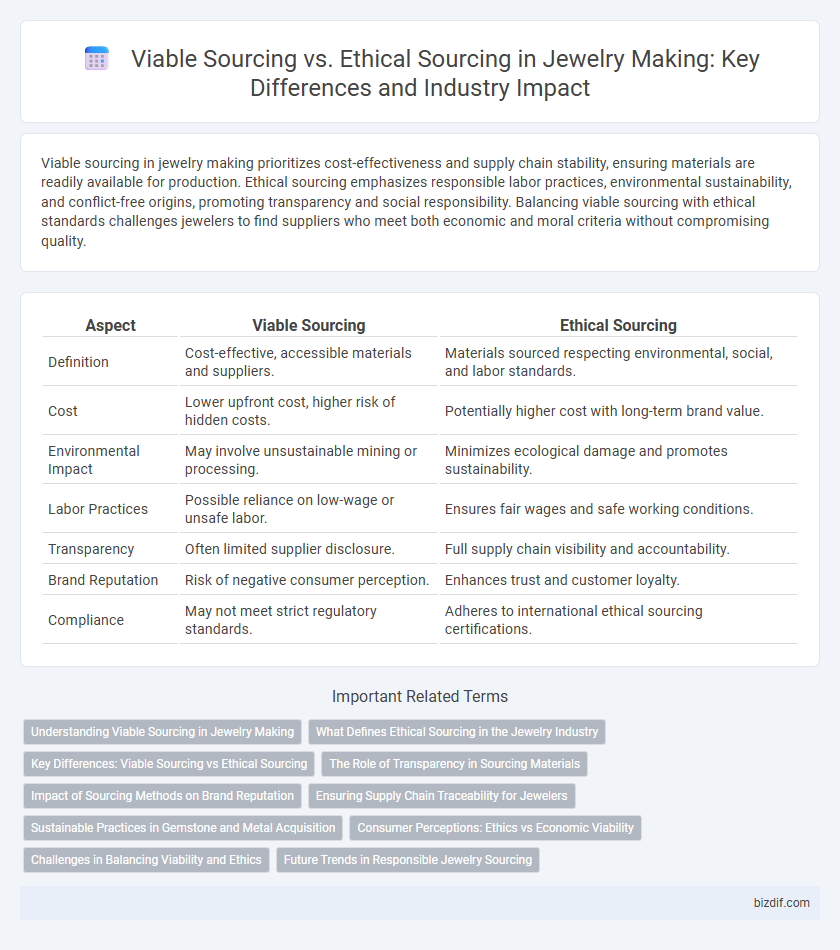Viable sourcing in jewelry making prioritizes cost-effectiveness and supply chain stability, ensuring materials are readily available for production. Ethical sourcing emphasizes responsible labor practices, environmental sustainability, and conflict-free origins, promoting transparency and social responsibility. Balancing viable sourcing with ethical standards challenges jewelers to find suppliers who meet both economic and moral criteria without compromising quality.
Table of Comparison
| Aspect | Viable Sourcing | Ethical Sourcing |
|---|---|---|
| Definition | Cost-effective, accessible materials and suppliers. | Materials sourced respecting environmental, social, and labor standards. |
| Cost | Lower upfront cost, higher risk of hidden costs. | Potentially higher cost with long-term brand value. |
| Environmental Impact | May involve unsustainable mining or processing. | Minimizes ecological damage and promotes sustainability. |
| Labor Practices | Possible reliance on low-wage or unsafe labor. | Ensures fair wages and safe working conditions. |
| Transparency | Often limited supplier disclosure. | Full supply chain visibility and accountability. |
| Brand Reputation | Risk of negative consumer perception. | Enhances trust and customer loyalty. |
| Compliance | May not meet strict regulatory standards. | Adheres to international ethical sourcing certifications. |
Understanding Viable Sourcing in Jewelry Making
Viable sourcing in jewelry making emphasizes obtaining materials that balance cost-effectiveness, availability, and quality to ensure sustainable production cycles. Jewelers prioritize reliable suppliers that provide consistent access to precious metals and gemstones while maintaining industry standards. This approach supports stable business operations but may not fully address the environmental or social impacts associated with raw material extraction.
What Defines Ethical Sourcing in the Jewelry Industry
Ethical sourcing in the jewelry industry is defined by transparency, fair labor practices, and environmental responsibility, ensuring that materials like gold, diamonds, and gemstones are obtained without exploitation or harm. It involves certification systems such as Fairtrade, Kimberley Process, and Responsible Jewellery Council to verify responsible mining and sourcing. Prioritizing traceability and accountability throughout the supply chain safeguards the rights of workers and promotes sustainable practices that protect ecosystems.
Key Differences: Viable Sourcing vs Ethical Sourcing
Viable sourcing in jewelry making emphasizes cost-effectiveness, availability, and supply chain reliability to ensure consistent material procurement; ethical sourcing prioritizes environmental sustainability, fair labor practices, and conflict-free gemstones to uphold social responsibility. Key differences lie in their core objectives: viable sourcing targets economic feasibility and production continuity, while ethical sourcing centers on moral considerations and transparency. Balancing both approaches is critical for jewelers aiming to maintain profitability and brand integrity in a socially conscious market.
The Role of Transparency in Sourcing Materials
Transparency in sourcing materials is crucial for both viable and ethical jewelry making, ensuring traceability from mine to market. Clear disclosure of origin and supply chain practices allows jewelers to validate ethical standards while maintaining sustainable sourcing. This openness builds consumer trust and fosters accountability throughout the jewelry production process.
Impact of Sourcing Methods on Brand Reputation
Viable sourcing prioritizes cost-efficiency and scalability, often relying on established suppliers with consistent quality, which can enhance brand reliability but may raise concerns over environmental and labor practices. Ethical sourcing emphasizes transparency, fair labor conditions, and sustainable materials, directly bolstering brand reputation among socially conscious consumers and fostering long-term trust. Brands that integrate ethical sourcing into their supply chains often experience increased customer loyalty and positive market differentiation.
Ensuring Supply Chain Traceability for Jewelers
Ensuring supply chain traceability in jewelry making requires a shift from solely viable sourcing to ethical sourcing practices that prioritize transparency and accountability. Jewelers who implement blockchain technology and certified conflict-free sourcing can verify the origin of precious metals and gemstones, reducing the risk of unethical mining practices. Emphasizing traceability strengthens brand reputation, aligns with consumer demand for sustainability, and supports responsible labor practices throughout the supply chain.
Sustainable Practices in Gemstone and Metal Acquisition
Viable sourcing in jewelry making emphasizes cost-effectiveness and supply chain reliability, whereas ethical sourcing prioritizes environmental stewardship and fair labor conditions. Sustainable practices in gemstone and metal acquisition include using recycled metals, supporting fair-trade mines, and minimizing ecological impacts through responsible extraction methods. Transparent supply chains and certification standards like Fairmined and the Responsible Jewellery Council promote accountability and long-term sustainability in the industry.
Consumer Perceptions: Ethics vs Economic Viability
Consumers increasingly prioritize ethical sourcing in jewelry making, valuing transparency in labor practices and environmental impact over mere cost-effectiveness. While viable sourcing ensures economic sustainability and affordability, ethical sourcing enhances brand reputation and drives long-term customer loyalty. Data shows 73% of consumers are willing to pay a premium for ethically sourced jewelry, indicating a shift toward values-based purchasing decisions.
Challenges in Balancing Viability and Ethics
Balancing viability and ethics in jewelry sourcing involves navigating complex challenges such as cost constraints, supply chain transparency, and labor practices. Jewelry makers often face higher expenses when choosing ethically sourced materials, impacting overall profitability and market competitiveness. Ensuring both sustainability and economic feasibility requires innovative strategies like supplier audits, traceability technologies, and consumer education on ethical value.
Future Trends in Responsible Jewelry Sourcing
Future trends in responsible jewelry sourcing emphasize a shift from merely viable sourcing, which prioritizes cost-efficiency, to comprehensive ethical sourcing that integrates environmental sustainability and fair labor practices. Innovations such as blockchain traceability and recycled precious metals are gaining traction, ensuring transparency and reducing the carbon footprint of jewelry supply chains. Consumer demand increasingly drives the market towards certifications like Fairtrade Gold and the Responsible Jewellery Council standards, signaling a lasting industry commitment to ethical responsibility.
Viable Sourcing vs Ethical Sourcing Infographic

 bizdif.com
bizdif.com